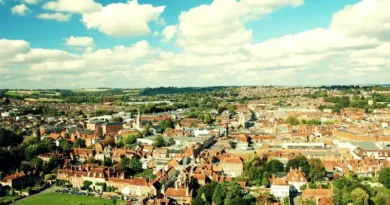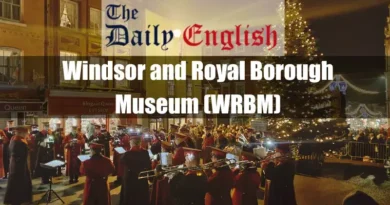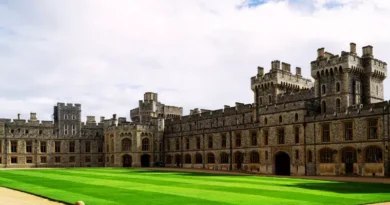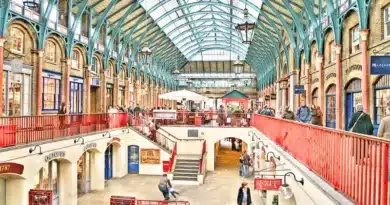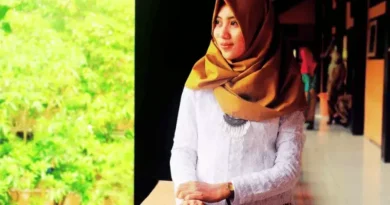The China Museum, Windsor Castle
Nestled within the majestic walls of Windsor Castle, the official residence of the British monarch, lies a treasure trove for porcelain enthusiasts—the China Museum. This haven for exquisite chinaware offers a glimpse into British royalty’s refined tastes and collecting habits over the centuries.
Key Takeaways
| Key Points | Details |
|---|---|
| A Royal Collection of Porcelain | – Established by Queen Mary, wife of King George V, to showcase the Royal Family’s porcelain collection. |
| – Initially focused on European porcelain, particularly Sèvres, later expanding to Chinese and Japanese pieces. | |
| A Journey Through Porcelain Eras | – Features Chinese and Japanese porcelain from the 17th & 18th centuries, admired for intricate designs. |
| – Includes the Sèvres collection, showcasing soft-paste porcelain with elegant decorations. | |
| Must-See Pieces | – The Meissen swan centrepiece: a lifelike masterpiece of European porcelain. |
| – A collection of Japanese Kakiemon porcelain notable for vibrant enamels and unique motifs. | |
| Beyond the Exhibits | – Royal Collection Shop: souvenirs inspired by the museum’s collection, such as teacups and plates. |
| – Educational resources include online guides, talks, and workshops. | |
| Planning Your Visit | – Entry included with the State Apartments tour ticket. |
| – Located in Windsor, Berkshire, England, accessible by car or train. | |
| – Partially accessible for visitors with disabilities (check website for details). | |
| – Entry is included with the State Apartments tour ticket. |
A Royal Display of Porcelain Excellence
The story of the China Museum begins with Queen Mary, consort to King George V. A passionate porcelain collector, Queen Mary envisioned a dedicated space to showcase the vast and exquisite collection amassed by the Royal Family. In 1923, her vision became a reality when a suite of rooms within the State Apartments was transformed into the China Museum.
History: Queen Mary’s Vision and the China Museum’s Evolution

The initial displays focused primarily on European porcelain, particularly the renowned Sèvres collection. However, over the years, the museum has expanded its scope to include a wider range of porcelain, with a significant emphasis on Chinese and Japanese pieces. This reflects the evolving tastes of the Royal Family and the growing appreciation for Asian porcelain in Europe during the 18th and 19th centuries.
The Collection: A Journey Through Porcelain Eras
Stepping into the China Museum is akin to embarking on a historical journey through the evolution of porcelain. Here, visitors are greeted by a dazzling array of objects, each meticulously displayed in elegant glass cabinets.
1. Chinese and Japanese Delights: 17th & 18th Century Masterpieces
The collection’s heart lies in the exquisite Chinese and Japanese porcelain pieces dating from the 17th and 18th centuries. Visitors can marvel at the delicate beauty of Chinese famille rose vases adorned with vibrant floral motifs and intricate bird designs. These pieces exemplify the pinnacle of Chinese porcelain artistry, renowned for its mastery of colour and detail.
Japanese porcelain is equally well-represented, with a captivating selection of Imari ware. Characterized by bold cobalt blue underglaze designs on a white background, Imari ware showcases the distinctive aesthetic sensibilities of Japanese ceramics.
2. European Elegance: The Sèvres Collection
The China Museum boasts an impressive collection of Sèvres porcelain, a highly coveted European brand established in the 18th Century. These meticulously crafted pieces, known for their soft-paste porcelain body and lavish decorations, were a favourite amongst European royalty. Visitors can admire the intricate floral arrangements, mythological scenes, and gilded details that adorn these exquisite objects, reflecting the height of European porcelain artistry.
Must-See Pieces in the Museum

While the entire collection is a visual feast, certain pieces stand out for their historical significance and artistic merit. A must-see is the magnificent Meissen swan centrepiece, a masterpiece of European porcelain renowned for its lifelike depiction of a swan with outstretched wings.
The museum also houses a captivating collection of Japanese Kakiemon porcelain, known for its vibrant enamels and unique design motifs. These pieces, prized for their rarity and beauty, offer a glimpse into the refined aesthetics of Japanese ceramic art.
Beyond the Exhibits: The Shop and Educational Resources

The China Museum experience extends beyond the captivating display of porcelain. Visitors can delve deeper into the world of ceramics through the following offerings:
- The Royal Collection Shop: Situated near the museum exit, the Royal Collection Shop provides a delightful opportunity to take a piece of history home. Here, visitors can find a curated selection of souvenirs inspired by the museum’s collection. The shop caters to various tastes and budgets, from elegant teacups with floral motifs to decorative plates featuring iconic designs.
- Educational Resources: The Royal Collection Trust manages the museum and offers many educational resources online and on-site. Visitors can access informative guides and interactive features that delve into porcelain production’s history, techniques, and artistic styles. Additionally, the museum occasionally hosts talks and workshops led by experts, providing deeper insights into the fascinating world of ceramics.
Planning Your Visit: Essential Information

To ensure a smooth and enriching visit, here’s some essential information to keep in mind:
- Opening Hours and Admission: The China Museum is open to the public as part of the State Apartments tour the Royal Collection Trust offers. Opening hours vary depending on the season, so it’s best to check the official website (https://www.rct.uk/) for the most up-to-date information. Ticket prices for the State Apartments tour include entry to the China Museum.
- Location and Accessibility: Windsor Castle is in Windsor, Berkshire, England. The castle is easily accessible by car or train, with ample parking facilities for those arriving by car. The State Apartments, including the China Museum, are partially accessible for visitors with disabilities. Detailed accessibility information is available on the Royal Collection Trust website.
- Guided Tours and Special Events: The State Apartments tour, which includes the China Museum, is self-guided. However, audio guides are available for purchase, providing an informative commentary on the collection. The Royal Collection Trust also occasionally hosts special events, such as curator talks and workshops focused on specific aspects of the porcelain collection.
Conclusion: A Treasure Trove for Porcelain Enthusiasts
The China Museum at Windsor Castle offers a unique glimpse into the world of royal collecting and the captivating art of porcelain. From exquisite Chinese masterpieces to European triumphs in design, the museum’s collection is a testament to the enduring allure of this delicate art form. Whether you’re a seasoned porcelain aficionado or simply someone who appreciates beauty and historical significance, a visit to the China Museum promises a delightful and enriching experience.
FAQ
What is the China Museum at Windsor Castle?
The China Museum, located within Windsor Castle, displays a remarkable collection of Chinese porcelain and ceramics amassed by the British royal family over centuries.
Where is the China Museum situated within Windsor Castle?
The China Museum is situated along the tour of the State Apartments. It allows visitors to admire original china pieces from the Royal Collection.
Is there an additional ticket price for the China Museum at Windsor Castle?
Access to the China Museum is included in the standard Windsor Castle admission ticket; no extra fee is required.
How much does a Windsor Castle admission ticket cost?
Standard admission prices are £35.00 for adults, £23 for young persons (18-24), and £15.70 for children (5-17). Under 5 Free, disabled £15.70 and caregivers free.
What are the opening hours of the China Museum?
The China Museum operates during Windsor Castle’s opening hours, typically Thursday to Monday, 10:00 to 16:15.
Can I purchase tickets for the China Museum online?
Yes, tickets for Windsor Castle, including access to the China Museum, can be purchased online through the Royal Collection Trust website.
Is photography allowed inside the China Museum?
Photography is not permitted inside the China Museum or Windsor Castle to preserve the artefacts and respect the historic setting. However, visitors are welcome to take photos of the castle’s exterior and surrounding areas.
Are guided tours available for the China Museum?
While specific guided tours of the China Museum may not be available, general tours of Windsor Castle often include this area.
Is there a cloakroom near the China Museum?
Yes, there is a security cloakroom in the China Museum at the State Apartments entrance for storing large baggage items.
Are there any special exhibitions in the China Museum?
The China Museum occasionally hosts special exhibitions; checking the Royal Collection Trust website for current information is best.




